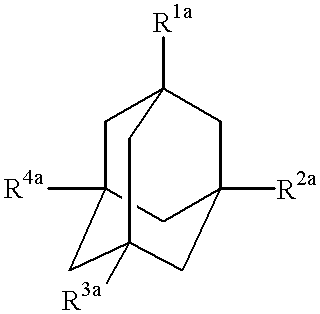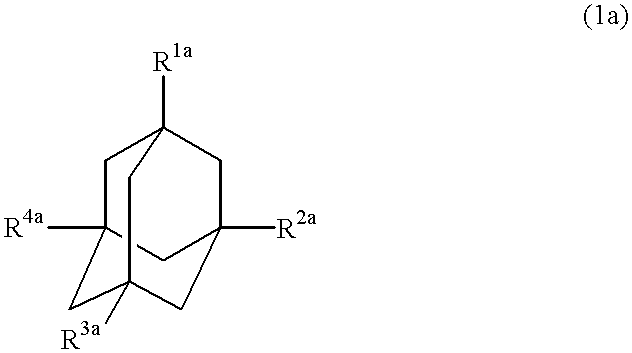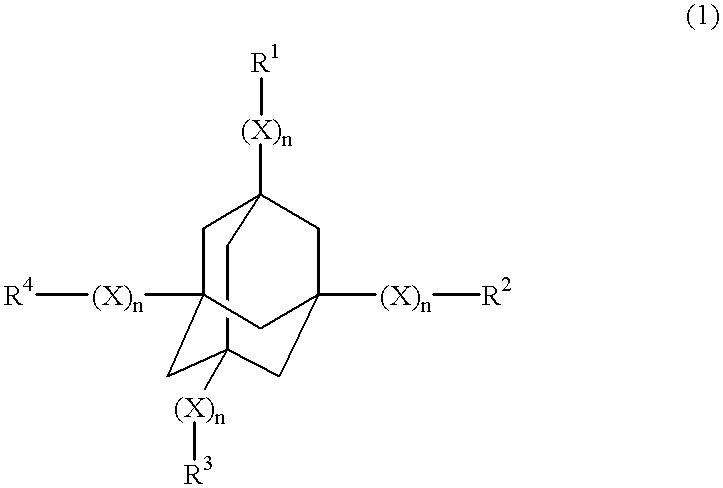Polymerizable adamantane derivatives and process for producing the same
- Summary
- Abstract
- Description
- Claims
- Application Information
AI Technical Summary
Benefits of technology
Problems solved by technology
Method used
Image
Examples
preparation example 1
To 25 mmol of acetic acid were added 10 mmol of adamantane, 1 mmol of N-hydroxyphthalimide (NHPI) and a binary co-catalyst [0.03 mmol of acetylacetonatovanadium V(AA).sub.3 and 0.02 mmol of actylacetonatomangan Mn(AA).sub.3 ], and the resultant mixture was stirred in an oxygen atmosphere at a temperature of 75.degree. C. for 6 hours. The products in the reaction mixture were analyzed by gas chromatography, and, as a result, the adamantane was converted into 1-adamantanol (yield: 37%). 1,3-adamantanediol (yield: 35%). 1,3,5-adamantanetriol (yield: 5%), 1,3,5,7-adamantane-tetranol (yield: 4%) with the adamantane conversion of 100%. The spectrum data of the 1,3,5,7-adamantanetetranol was as follows:
.sup.1 H-NMR(CDCl.sub.3).delta.: 1.602, 4.893
.sup.13 C-NMR(CDCl.sub.3).delta.: 52.3, 71.6
IR(cm.sup.-1): 3306, 2947, 1455, 1332, 1210, 1046, 1004, 971, 559
preparation example 2
To 25 ml of acetic acid were added 10 mmol of adamantane,2 mmol of NHPI and 0.1 mmol of acetylacetonatovanadium V(AA).sub.3, and the resultant mixture was stirred in an oxygen atmosphere at a temperature of 85.degree. C. for 10 hours. The analysis of the product in the reaction mixture revealed that the adamantane was converted into 1-adamantanol (yield: 8%), 1,3-adamantanediol (yield: 22%), 1,3,5-adamanetriol (yield: 33%) and 1,3,5,7-adamantanetetraol (yield: 20%) with the adamantane conversion of 99%.
preparation example 3
To 25 ml of acetic acid were added 10 mmol of adamantane, 0.8 mmol of NHPI and 0.6 mmol of acetylacetonatocobalt(II)Co(AA).sub.2 , and the resultant mixture was stirred in an oxygen atmosphere at a temperature of 75.degree. C. for 3 hours. The products in the reaction mixture were analyzed by gas chromatography, and, as a result, adamantane was converted into 1-adamantanol (yield: 48%) and 1,3-adamantanediol(yield: 13%) with the adamantane conversion of 65%.
PUM
| Property | Measurement | Unit |
|---|---|---|
| Current | aaaaa | aaaaa |
| Current | aaaaa | aaaaa |
| Current | aaaaa | aaaaa |
Abstract
Description
Claims
Application Information
 Login to View More
Login to View More - R&D
- Intellectual Property
- Life Sciences
- Materials
- Tech Scout
- Unparalleled Data Quality
- Higher Quality Content
- 60% Fewer Hallucinations
Browse by: Latest US Patents, China's latest patents, Technical Efficacy Thesaurus, Application Domain, Technology Topic, Popular Technical Reports.
© 2025 PatSnap. All rights reserved.Legal|Privacy policy|Modern Slavery Act Transparency Statement|Sitemap|About US| Contact US: help@patsnap.com



